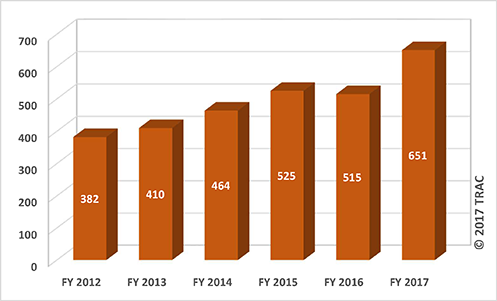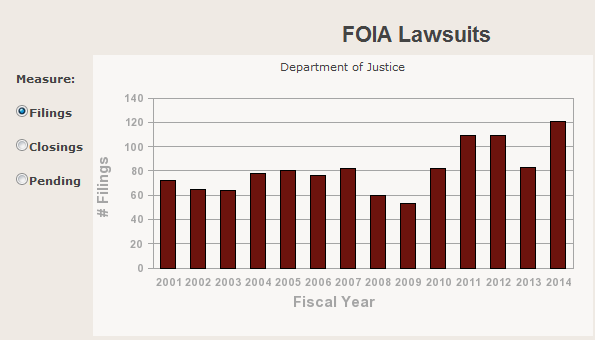FOIA Lawsuits Surge in Trump Administration’s First Year
Since the new administration took office at the end of January 2017, there has been a sharp jump in the number of lawsuits filed by individuals and organizations seeking court orders to obtain federal government records.[1] Suits brought by the news media and nonprofit advocacy organizations have fueled a significant part of this rise. Under the Freedom of Information Act (FOIA), requesters can file suit when information they are seeking is withheld and they have exhausted administrative appeals, or when the agency fails to even respond in a timely manner.
Lawsuits this past fiscal year rose an astonishing 26 percent, and are continuing to climb. FOIA court cases are now up over 70 percent from just five years ago. See Figure 1.
 Figure 1. FOIA Lawsuits Jump 26% in FY 2017
Figure 1. FOIA Lawsuits Jump 26% in FY 2017Court backlogs of pending FOIA litigation have climbed even faster, with hundreds of cases waiting resolution. Indeed, the backlog is already approaching 900 cases and unless steps are taken may top a thousand in the near future.
This unprecedented increase was identified as a real crisis at a recent symposium convened at the Villanova University School of Law. The FOIA Project’s co-directors were asked to address the gathering in its opening session on the project’s findings. Representatives from media and advocacy organizations who were active FOIA litigants also brought their concerns to the forum.[2]
This deluge of new litigation, along with the increased costs and burdens they impose, have captured the attention of Congress and some federal officials. At the symposium, the director of the Justice Department’s Federal Programs Branch—the branch responsible for defending federal agency withholding—spoke, as did the new director of Government Information Services who serves as the government-wide FOIA ombudsman. They each singled out the growing avalanche of FOIA lawsuits and the need to address their root causes as a top concern.
Updated FOIA Lawsuit App Released
Accompanying this report, FOIAproject.org has just updated the project’s FOIA Lawsuit App. This free user tool allows the public to drill into these numbers to track FOIA litigation trends over time[3].
The tool tracks new suits filed, along with the number of suits closed each year by federal district courts. Information is featured on how long suits have taken to complete. The backlog of FOIA cases currently pending before federal district courts is further detailed, along with how long cases have been waiting resolution. Comparable figures for the pending caseload at the end of previous years are also included.
Users can examine overall figures, or drill in by government department, by agencies within departments, and by independent agencies.
Which Federal Agencies Are Sued Most Often
The Department of Justice with 197 FOIA lawsuits – a jump of 33 – was sued the most often, followed by the Department of Homeland Security with 98 suits. These two agencies also ranked first and second as the most frequented sued agencies during FY 2016.
The Department of Interior with 68 new FOIA suits filed against it moved up in the rankings from fifth place in FY 2016 to third place in FY 2017. In contrast, the Department of State experienced fewer lawsuits during FY 2017 than during FY 2016. It fell to fifth place during 2017.
With 50 or more lawsuits in each of the last two years, the Department of Defense retained its fourth place ranking.
The agencies experiencing significantly more FOIA lawsuits often were government offices in charge of areas where there was heightened public concern. The Environmental Protection Agency, for example, experienced an unusually large jump, with 25 more lawsuits during FY 2017 than in the previous year.
Three additional agencies saw a substantial increase in challenges to the handling of its FOIA requests. Each of these saw at least 10 more lawsuits last year as compared with the last year of the Obama administration. These agencies were: the Department of Commerce; the Executive Office of the President, Office of Management and Budget; and the Department of Education.
Table 1 lists the number of FOIA suits and relative litigation rankings for each federal agency that was sued at least once during this two year period.
| Rank | Federal Agency | New FOIA Lawsuits | FY 2017 vs 2016 | |||
|---|---|---|---|---|---|---|
| FY 2016 | FY 2017 | FY 2016 | FY 2017 | Chg # | Chg % | |
| 1 | 1 | Department of Justice | 164 | 197 | 33 | 20% |
| 2 | 2 | Department of Homeland Security | 67 | 98 | 31 | 46% |
| 5 | 3 | Department of the Interior | 42 | 68 | 26 | 62% |
| 4 | 4 | Department of Defense | 50 | 56 | 6 | 12% |
| 3 | 5 | Department of State | 59 | 55 | -4 | -7% |
| 6 | 6 | Treasury | 41 | 50 | 9 | 22% |
| 11 | 7 | Environmental Protection Agency | 10 | 35 | 25 | 250% |
| 7 | 8 | Department of Health and Human Services | 29 | 28 | -1 | -3% |
| 8 | 9 | Central Intelligence Agency | 27 | 26 | -1 | -4% |
| 9 | 10 | U.S. Department of Agriculture | 19 | 22 | 3 | 16% |
| 10 | 11 | Department of Veterans Affairs | 13 | 19 | 6 | 46% |
| 15 | 11 | Department of Commerce | 8 | 19 | 11 | 138% |
| 11 | 13 | Office of the Director of National Intelligence | 10 | 16 | 6 | 60% |
| 23 | 14 | Executive Office of the President, Office of Management and Budget | 3 | 13 | 10 | 333% |
| 23 | 14 | Department of Education | 3 | 13 | 10 | 333% |
| 14 | 16 | Department of Transportation | 9 | 10 | 1 | 11% |
| 11 | 17 | Department of Energy | 10 | 9 | -1 | -10% |
| 16 | 18 | Social Security Administration | 7 | 7 | 0 | 0% |
| 17 | 18 | U.S. Department of Labor | 6 | 7 | 1 | 17% |
| 23 | 18 | U. S. General Services Administration | 2 | 7 | 5 | 250% |
| 18 | 21 | National Archives & Records Administration | 5 | 6 | 1 | 20% |
| 19 | 21 | United States Postal Service | 4 | 6 | 2 | 50% |
| 23 | 23 | Federal Communications Commission | 2 | 4 | 2 | * |
| 19 | 24 | Office of Personnel Management | 4 | 3 | -1 | * |
| 19 | 24 | Department of Housing and Urban Development | 4 | 3 | -1 | * |
| 23 | 24 | Consumer Financial Protection Bureau | 2 | 3 | 1 | * |
| 30 | 24 | U.S. Small Business Administration | 1 | 3 | 2 | * |
| 30 | 24 | U.S. Agency for International Development | 1 | 3 | 2 | * |
| 30 | 24 | Federal Election Commission | 1 | 3 | 2 | * |
| 19 | 30 | Securities and Exchange Commission | 4 | 2 | -2 | * |
| 23 | 30 | Council on Environmental Quality | 2 | 2 | 0 | * |
| 30 | 30 | U.S. Equal Employment Opportunity Commission | 1 | 2 | 1 | * |
| 30 | 30 | Board of Governors of the Federal Reserve System | 1 | 2 | 1 | * |
| 42 | 30 | U.S Office of Special Counsel | 0 | 2 | 2 | * |
| 42 | 30 | National Aeronautics and Space Administration | 0 | 2 | 2 | * |
| 42 | 30 | Election Assistance Commission | 0 | 2 | 2 | * |
| 30 | 37 | U.S. Consumer Product Safety Commission | 1 | 1 | 0 | * |
| 30 | 37 | Executive Office of the President | 1 | 1 | 0 | * |
| 42 | 37 | U.S. Office of Government Ethics | 0 | 1 | 1 | * |
| 42 | 37 | Federal Trade Commission | 0 | 1 | 1 | * |
| 42 | 37 | Federal Energy Regulatory Commission | 0 | 1 | 1 | * |
| 42 | 37 | Chemical Safety and Hazard Investigation Board | 0 | 1 | 1 | * |
| 42 | 37 | Broadcasting Board of Governors | 0 | 1 | 1 | * |
| 23 | 44 | Federal Deposit Insurance Corporation | 2 | 0 | -2 | * |
| 30 | 44 | National Transportation Safety Board | 1 | 0 | -1 | * |
| 30 | 44 | Merit Systems Protection Board | 1 | 0 | -1 | * |
| 30 | 44 | District of Columbia Office | 1 | 0 | -1 | * |
| 30 | 44 | Court Services and Offender Supervision Agency | 1 | 0 | -1 | * |
| 30 | 44 | Commodity Futures Trading Commission | 1 | 0 | -1 | * |
* Percentage change calculated only if 5 or more lawsuits filed in FY 2017.
Footnotes
[1] Last May the FOIA Project documented that FOIA lawsuits had already reached the highest level recorded in 25 years. See:
http://foiaproject.org/2017/05/23/lawsuits-25year-high/.

